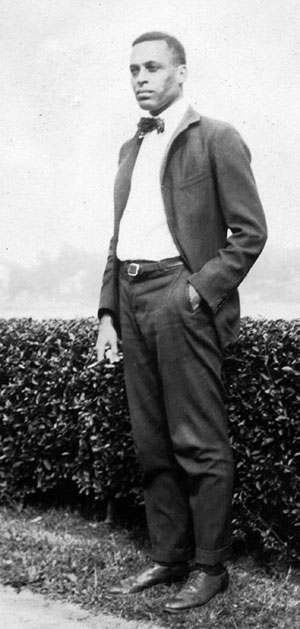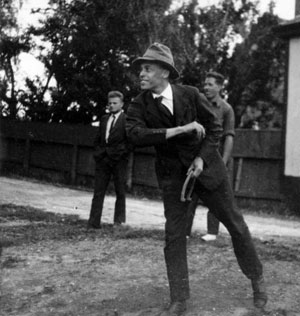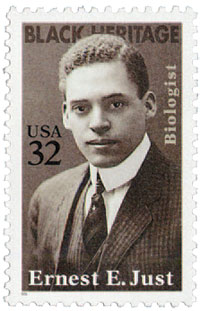Ernest Everett Just:
experimental biologist par excellence
For almost 40 years after the end of World War II, the work of Ernest Everett Just, an African-American biologist known for his studies of fertilization and early development in marine invertebrates, lay forgotten, buried in the scientific literature. Then, in 1983, Kenneth R. Manning, a historian of science at Massachusetts Institute of Technology, published a prize-winning biography titled “Black Apollo of Science: The Life of Ernest Everett Just” (1). Stephen Jay Gould (2) favorably reviewed Manning’s book and wrote a column in the magazine Natural History about Just (3). Since then, a number of events have taken place that have brought increased attention to Just: A stamp honoring him was issued; symposia were held in his honor, the most recent at Howard University in 2008; and, in 2009, a special issue of the journal Molecular Reproduction and Development dedicated to Just was published (4). Yet still, E. E. Just and his contributions remain largely unknown to biologists.
A career in fertilization and development
 Ernest Everett Just outside the Marine Biological Laboratory in 1921. The Marine Biological Laboratory Archives
Ernest Everett Just outside the Marine Biological Laboratory in 1921. The Marine Biological Laboratory Archives
Born in 1883 in Charleston, S.C., Just attended the Kimball Union Academy, a boarding school in Meriden, N.H., graduating in 1903. He then enrolled at Dartmouth College and graduated magna cum laude in 1907 as an esteemed Rufus Choate scholar. He immediately accepted a teaching position at Howard University in Washington, D.C., where he quickly rose through the academic ranks, becoming full professor in 1912. He chaired the department of zoology at Howard and, with the help of the Rosenwald Fund, established a master’s program in that field.
In 1909, Just began making annual summer excursions to the Marine Biological Laboratory in Woods Hole, Mass., where he worked under renowned embryologist Frank R. Lillie. Almost from the beginning, his work was significant. His first paper (5) showed that the sperm entry point determines the first cleavage plane in the egg of the marine annelid Nereis limbata. The body of work for his doctoral degree, which he obtained from the University of Chicago in 1916, was based on his study of the breeding habits of N. limbata and Platynereis megalops (another annelid) and the fertilization reaction of the sand dollar Echinarachnius parma. While at the MBL, he rose from student apprentice to internationally respected scientist.
Just was known at Woods Hole and beyond for his uncanny ability to coax marine invertebrate embryos to develop normally, and many sought his advice on the proper handling of marine animal eggs and embryos. He compiled a set of indices of normal development based mainly on the timing and quality of fertilization envelope separation, allowing him to predict with great certainty whether or not development would be normal for a given egg. In 1939, he published a laboratory manual, “Basic Methods for Experiments on Eggs of Marine Animals” (6), which applied his deep storehouse of knowledge on egg handling.
Not content with simply studying the marine life around Woods Hole, in 1929 Just traveled to the Stazione Zoologica Anton Dohrn in Naples, Italy, to investigate fertilization in several European sea urchins and to determine whether the Mediterranean annelid Nereis dumerilii was the same as the North American species Platynereis megalops, as some had postulated. (It was not.) Then, in 1930, he received in invitation by Max Hartmann, the famous German embryologist, to visit the Kaiser-Wilhelm Institut für Biologie near Berlin. An invitation of this kind extended to an American was unprecedented, but the Germans saw an affinity between Just’s work and their own. They wanted to see if his ideas about the importance of the cell cortex (the structured layer just beneath the cell surface) could be applied to protists such as Amoeba proteus, which they had been studying.
Altogether, Just made nine excursions to Europe. In addition to his trips to Berlin and Naples, he traveled to the Sorbonne in Paris, where he spent some time completing his second book, “The Biology of the Cell Surface” (7), which brought his scientific work and his general ideas together as one synthetic whole. Of the 70 articles he published over the course of his 30-year career, several were in German journals, including one in Naturwissenschaften that, for the first time, correlated changes in cell adhesiveness with developmental stages during the early embryonic cleavage process (8). After 1936, Just’s papers became increasingly philosophical. This reflected both his desire to apply his ideas about the importance of the cell surface more broadly and his increased willingness to challenge those American counterparts (notably Thomas Hunt Morgan and Jacques Loeb) whom he saw as too reductionistic.
In 1938, bereft of funding and rejected by many of his American colleagues because of his opposition to their reductionistic views, Just initiated a self-imposed exile in Europe. He took up research at the Station Biologique at Roscoff, a small French fishing village on the English Channel. But in 1940, the Nazis invaded the region around Paris, including Roscoff, and Just was forced to leave. He returned to the United States and Howard University. In 1941, however, he fell tragically ill with pancreatic cancer, and, by the end of October, he died.
A variety of scientific contributions
 Many researchers and instructors, including Ernest Everett Just, played horseshoes at the Marine Biological Laboratory during the summers. Alfred Huettner and The Marine Biological Laboratory Archives
Many researchers and instructors, including Ernest Everett Just, played horseshoes at the Marine Biological Laboratory during the summers. Alfred Huettner and The Marine Biological Laboratory Archives
Just’s contributions lay in several areas, including (a) the role of environmental factors in development; (b) the fast and slow blocks to polyspermy during fertilization; (c) experimental parthenogenesis; and (d) embryo morphogenesis.
Role of environmental factors in development
Just investigated the effect of a number of variables – dilute or concentrated sea water, ultraviolet irradiation, temperature, hydration or dehydration— on embryo development. He was intimately familiar with the natural history and breeding habits of the animals whose eggs he studied, and he strove to apply what he learned about development in natural settings to the laboratory. He was very much concerned with what he called the “normality” of the egg, i.e., how well its condition in the laboratory corresponds to the natural, fertilizable state. In these respects, Just’s work shares much in common with what is known today as ecological developmental biology (see 10, 11), which focuses on development in its natural environmental context.
Fast and slow blocks to polyspermy
Using only a light microscope, Just was able to observe the detailed structural changes that occur at the egg surface during fertilization. As early as 1919, he observed the “wave of negativity” that sweeps over the egg cell at the onset of fertilization envelope separation, preventing fertilization by more than one spermatozoon (polyspermy). He correctly reasoned that it was this wave, not the physical separation of the envelope, that is responsible for the initial block to polyspermy. Thus, Just is credited with being the first to infer what is known as the “fast block to polyspermy,” a phenomenon that subsequently has been shown to be due to a shift in egg cell membrane potential. Just also observed the “slow block to polyspermy,” a mechanical block which occurs as a result of the formation of the fertilization envelope itself. Just is best known for his inference and documentation of these two blocks to polyspermy.
Experimental parthenogenesis
While at Woods Hole, Just investigated the effect of a number of factors on the artificial activation of eggs in the absence of sperm, a phenomenon known as experimental parthenogenesis. His work there led to the public disagreement he had with Jacques Loeb, a prominent biologist at the Rockefeller Institute for Medical Research (now Rockefeller University) in New York. Loeb believed that, by tapping into the power of parthenogenesis, humans could gain mastery over nature and engineer it to their benefit. Just was strongly opposed to Loeb’s reductionism, but he also was critical of what he considered to be Loeb’s sloppy experimental technique, which he felt had led Loeb to conclusions that were not valid. Just proved that the method of experimental parthenogenesis Loeb pioneered, known as the double treatment method, in which the egg is treated with hypertonic sea water and then butyric acid, was not sound. He showed that the order of treatment was entirely inconsequential and that only one of the two agents was needed to induce parthenogenesis. But what Just rebelled against most was Loeb’s notion that the egg’s activation was the result of something being done to the egg. In contrast, Just believed that the critical, operative feature behind the activation was an intrinsic property of the egg itself, namely its “independent irritability.” Moreover, this property of the egg was an epiphenomenon of the ectoplasm (the structured layer below the cell surface), which Just believed played the dominant role in development, heredity and evolution.
Embryo morphogenesis
There is evidence that two of Just’s discoveries influenced some of the work for which pioneering embryologist Johannes Holtfreter is best known (12). First, Just’s discovery of the developmental stage-dependent adhesiveness of the blastomeres of the starfish cleavage embryo (8) contributed to Holtfreter’s discovery of tissue affinity, which is critically important during amphibian morphogenesis. Second, Just’s discovery of the independent irritability of the egg cell, mentioned above, strongly informed Holtfreter’s elucidation of autoinduction, the process by which amphibian gastrula ectoderm is induced by nonspecific agents to form neural tissue. An acknowledgment of these contributions extends the impact of Just’s work into the area of embryo morphogenesis, and it connects his work to important embryo research that is taking place today.
Challenging established views
It is clear from Just’s writings that he believed that life arose out of the complexity and structural integrity of living systems. In “The Biology of the Cell Surface” (7), he wrote that “life is the harmonious communion of events, the resultant of the communion of structures and reactions.” Just rejected purely mechanistic explanations, yet he also was not a vitalist. Rather, he took the middle position (3), embracing what is known as “organicism,” or materialistic holism, which posits that cells and organisms are “more than the sum of their parts” (9). According to this view, the properties of any level of organization (molecule, cell, tissue, whole organism) depend on the properties of the parts of the level below, as well as on the properties of the whole into which they are integrated. Moreover, properties are said to emerge out of the organizational complexity of the living system. This approach to biological investigation has much in common with what is known today as integrative systems biology, in which a top-down view is just as important as a bottom-up view for understanding the system.
 In February 1996, Ernest Everett Just was honored with a U.S. Black Heritage postage stamp.
In February 1996, Ernest Everett Just was honored with a U.S. Black Heritage postage stamp.
As an organicist, Just was squarely in the company of other classical embryologists, who held similar views. What made Just different from his peers was his unflinching willingness to take on giants of biology in his quest— fueled by his conviction about the importance of the cell periphery— to defend the holistic integrity of the developing organism. For instance, at the 1935 American Society of Zoologists meeting in Princeton, N.J., he publicly challenged Nobel laureate Thomas Hunt Morgan for his gene-centered view of development. Morgan had proposed that genes arranged in linear arrays on chromosomes are both the units of inheritance and the controllers of the developmental process. In opposition, Just presented his own cytoplasm-centered “theory of genetic restriction” to explain how differentiation occurs during development. Although ultimately incorrect, Just’s explanation nonetheless contained some elements of truth. Indeed, today we are learning that differential gene expression is a multi-faceted process with epigenetic, as well as genetic, components.
An examination of the life and work of E. E. Just provides several insights relevant to us today. First, although Just experienced crushing inequalities due to his being black in early 20th-century America, he nonetheless made significant contributions to biology. These contributions still resonate today in several areas: fertilization research, the emerging field of ecological developmental biology, integrative systems biology, epigenetics (in the broad sense) and embryo research. Second, Just did not hesitate to challenge prominent biologists whom he felt were incorrect in their overtly nucleocentric or reductionistic view of the cell or organism. Thus, Just’s example provides support to all young scientists today whose work leads them to challenge the accepted paradigms. Third, Just emphasized the importance of preserving the integrity of the cell or organism under investigation in the laboratory. “The cell is never a tool,” he wrote. It is a living system and not a machine that can be used to “prove a theory” (7). As we biochemists and molecular biologists go about our work to understand the molecular structure and function of living systems, we would do well to heed Just’s words. The top-down view should always be kept in mind.
References
1. Manning, K. R. (1983) Black Apollo of Science: The Life of Ernest Everett Just. Oxford University Press.
2. Gould, S. J. (1988) Thwarted Genius. in An Urchin in the Storm: Essays about Books and Ideas. W. W. Norton and Co., pp. 169–179.
3. Gould, S. J. (1985) Just in the Middle: A Solution to the Mechanist-Vitalist Controversy in The Flamingo’s Smile: Reflections in Natural History. W. W. Norton and Co., pp. 377–391.
4. Byrnes, W. M. (2009) Introduction to the Special Issue. Mol. Reprod. Dev. 76, 1.
5. Just, E. E. (1912) The Relation of the First Cleavage Plane to the Entrance Point of the Sperm. Biol. Bull. 22, 239–252.
6. Just, E. E. (1939) Basic Methods for Experiments on Eggs of Marine Animals. P. Blakiston’s Son and Co.
7. Just, E. E. (1939) The Biology of the Cell Surface. P. Blakiston’s Son and Co.
8. Just, E. E. (1931) Die Rolle des Kortikalen Cytoplasmas bei Vitalen Ersheinungen. Naturwiss. 19, 953–1001.
9. Gilbert, S. F., and Sarkar, S. (2000) Embracing Complexity: Organicism for the 21st Century. Dev. Dynam. 219, 1–9.
10. Byrnes, W. M., and Eckberg, W. R. (2006) Ernest Everett Just (1883-1941) – An Early Ecological Developmental Biologist. Dev. Biol. 296, 1–11.
11. Gilbert, S. F., and Epel, D. (2009) Ecological Developmental Biology: Integrating Epigenetics, Medicine, and Evolution. Sinauer Associates.
12. Byrnes, W. M. (2009) Ernest Everett Just, Johannes Holtfreter, and the Origin of Certain Concepts in Embryo Morphogenesis. Mol. Reprod. Dev. 76, 912–921.
Enjoy reading ASBMB Today?
Become a member to receive the print edition four times a year and the digital edition monthly.
Learn moreGet the latest from ASBMB Today
Enter your email address, and we’ll send you a weekly email with recent articles, interviews and more.
Latest in People
People highlights or most popular articles

Sketching, scribbling and scicomm
Graduate student Ari Paiz describes how her love of science and art blend to make her an effective science communicator.

Embrace your neurodivergence and flourish in college
This guide offers practical advice on setting yourself up for success — learn how to leverage campus resources, work with professors and embrace your strengths.

Survival tools for a neurodivergent brain in academia
Working in academia is hard, and being neurodivergent makes it harder. Here are a few tools that may help, from a Ph.D. student with ADHD.

Quieting the static: Building inclusive STEM classrooms
Christin Monroe, an assistant professor of chemistry at Landmark College, offers practical tips to help educators make their classrooms more accessible to neurodivergent scientists.

Hidden strengths of an autistic scientist
Navigating the world of scientific research as an autistic scientist comes with unique challenges —microaggressions, communication hurdles and the constant pressure to conform to social norms, postbaccalaureate student Taylor Stolberg writes.

Richard Silverman to speak at ASBMB 2025
Richard Silverman and Melissa Moore are the featured speakers at the ASBMB annual meeting to be held April 12-15 in Chicago.

